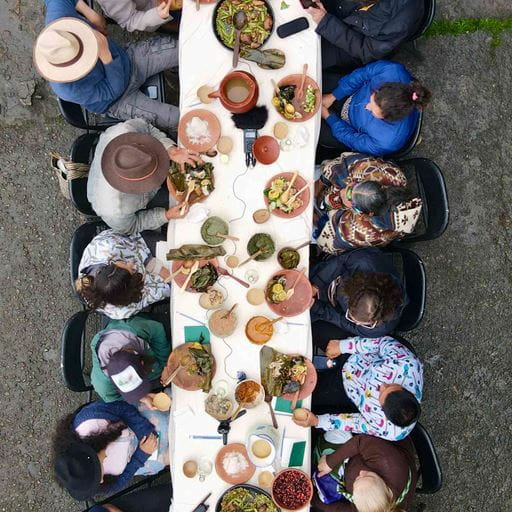Bogotá River inspires lunch with water activists
-
Date
Wed 3 May 23

Artists, environmentalists and community groups restoring and protecting one of the world’s most polluted rivers have met for a ritual meal curated using ingredients sourced from its waters and banks.
The communal lunch, held at the iconic Tequendama Falls on the Bogotá River in Colombia, was organised by Dr Lisa Blackmore, from the School of Philosophy and Art History.
Dr Blackmore’s research team, which includes Colombians Laura Giraldo-Martínez, Diego Piñeros García and Juliana Steiner, have been exploring how local communities have been caring for the river.
They have identified and mapped grassroots water management collectives, organic farming and wetland restoration groups, environmental educators and artists who lead projects restoring and protecting the area.
The lunch marks a significant point in a long-term project which aims to co-create a digital platform using film, podcasts and publications to tell the stories of inspirational community leaders living and working on the Bogotá River. It is part of Dr Blackmore’s wider work with the entre—ríos collective which explores and reignites relationships between people and bodies of water.
The lunch menu, which was sourced from the length of the river, included organic ingredients cultivated without chemicals to care for the water courses. It featured recipes inspired and made by local community members and ancestral fermented drinks, such as chicha and mazamorra made in Muysca indigenous settlements.
The entire spread was researched and curated by artist-anthropologist-cook duo Cristina Consuegra and Carlos Alfonso. It created an opportunity to celebrate the central role the river plays in people’s lives and to connect activists and organisations active along the river.
The lunch also gave Dr Blackmore and colleagues the chance to better understand the landscape, agendas and actions of those involved in caring for the water body, how the river’s contamination affects local inhabitants and how the project might support local initiatives in the future.
Dr Blackmore, who is also working with colleagues from Wageningen University, Netherlands, on the project explained: “For centuries, the Bogotá River has been the life source and energy for inhabitants of Bogotá’s flat savannah. Despite decades of being declared a liquid corpse, communities along it are taking action to care for this polluted body of water.
“However, they are overlooked by the State-led discussions about large-scale sanitation infrastructure in the region and media images that focus only on lethal contamination and water treatment infrastructure risk disconnecting Bogotá’s inhabitants from their river, turning it into a lost cause. We want to shift the narrative and tell different stories about this river, focusing on the people that care for it.”
A film of the lunch event will provide one of the first pieces of digital content that will help tell the story of the river and its inhabitants as well as shape future community workshops and public events that will inform Dr Blackmore’s final report.
The project has been funded by Essex’s Centre for Public and Policy Engagement.
.jpg?mh=500&mw=500&hash=6568B6C9CCF5290A596BEF6678B6AD0E)



